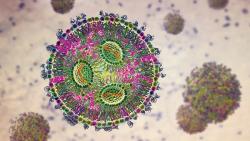
OR WAIT null SECS
- About Us
- Advertise
- Contact Us
- Editorial Info
- Editorial Contacts
- Editorial Advisory Board
- Do Not Sell My Personal Information
- Privacy Policy
- Terms and Conditions
© 2024 MJH Life Sciences™ and Pharmaceutical Technology. All rights reserved.
May I Present the Neoantigen
Experts believe it is likely cancer cells are more common in the body than previously thought, but typically caught early and removed in the body’s cancer-immune cycle. When the system is in good working order (and protecting us), dead cancer cells release neoantigens.
Experts believe it is likely cancer cells are more common in the body than previously thought, but typically caught early and removed in the body’s cancer-immune cycle. When the system is in good working order (and protecting us), dead cancer cells release neoantigens, which are acquired by dendritic cells and moved to a nearby draining lymph node for disposal. Dendritic cells then present this antigen to T cells, which become effector T cells, and after a few more steps, “move through the blood toward the tumor tissue. These T cells then infiltrate into the tumor and recognize and bind the MHC-I–antigen complex presented by cancer cells through the T cell receptor. Through these processes, cancer cells are finally killed. …When cancer cells die and additional neoantigens are released, the immune reaction continues the cycle again from the first step. [However], in cancer patients, at least one of these steps is defective and the cancer-immune cycle does not work properly” (1).
The obvious utility in identifying tumor neoantigens is consolidating in weight and importance, leading to coordinated leapfrog advances in pharmaceutical sciences. But each patient has their own personal biology, creating their own personal tumor microenvironment (e.g., there are more than 24,000 distinct human leukocyte antigens) (2). A paper describing a powerful new identification platform was briefly discussed in an interview with Pharmaceutical Technology® (3), where study author, Stephen Schoenberger, told PharmTech’s editor “we let the patient’s immune system tell us which mutations can be confirmed as neoantigens and then have asked whether there are bioinformatically quantifiable features of these mutations apparent in genomic sequence data. Our goal in doing so is a computational prioritization algorithm of sufficient predictive power as to obviate the need for in vitro functional validation step, as this would be difficult to scale for the number of patients that our findings suggest could benefit from personalized immunotherapy” (3).
References
- Kim, S.; Cho, S. The Evasion Mechanisms of Cancer Immunity and Drug Intervention in the Tumor Microenvironment. Front. Pharmacol. 2022 May 24:13:868695. DOI: 10.3389/fphar.2022.868695. eCollection 2022.
- Fu, L.; Huang, C.; Huang. Z. Neoantigens: Promising Targets for Cancer Therapy. Signal Transduction and Targeted Therapy. 2023 8 article 9. Nature.com, https://www.nature.com/articles/s41392-022-01270-x
- Spivey, C. Research into Cold Cancers Heating Up. PharmTech.com, March 4, 2024.
About the Author
Mike Hennessy Jr. is the President and CEO of MJH Life Sciences®.
Article details
Pharmaceutical Technology®
Vol. 48, No. 4
April 2024
Page: 10
Citation
When referring to this article, please cite it as Hennessy, M. May I Present the Neoantigen. Pharmaceutical Technology ® 2024 48 (4).

 Download Issue: Pharmaceutical Technology, April 2024
Download Issue: Pharmaceutical Technology, April 2024

